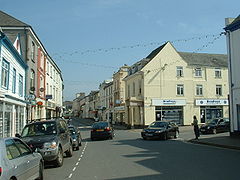Callington
This article needs additional citations for verification. (March 2010) |
Callington
| |
|---|---|
 Fore Street, Callington's main street | |
| Population | 4,783 (Parish, 2001) |
| OS grid reference | SX359696 |
| Civil parish |
|
| Unitary authority | |
| Ceremonial county | |
| Region | |
| Country | England |
| Sovereign state | United Kingdom |
| Post town | CALLINGTON |
| Postcode district | PL17 |
| Dialling code | 01579 |
| Police | Devon and Cornwall |
| Fire | Cornwall |
| Ambulance | South Western |
| UK Parliament | |
Callington (Template:Lang-kw) is a civil parish and town in southeast Cornwall, United Kingdom. The town is situated approximately seven miles (11 km) north of Saltash and nine miles south of Launceston[1].
Callington parish had a population of 4,783 in 2001, according to the 2001 census.
Geography
The town is situated in east Cornwall between Dartmoor to the east and Bodmin Moor to the west. A former agricultural market town, it lies at the intersection of the south-north A388 Saltash to Launceston road and the east-west A390 Tavistock to Liskeard road.
Kit Hill is a mile northeast of the town and rises to 333 metres (1,093 ft) with views of Dartmoor, Bodmin Moor and the River Tamar.
Railway station
Callington railway station was the terminus for a branch line that ran from Bere Alston, the junction with the Southern Railway's Tavistock to Plymouth line. The railway line beyond Gunnislake to the Callington terminus was closed in the 1960s, due to low usage and the fact that the final sections of the line had several severe gradients and speed restrictions which made operating difficult. It is still possible to travel by rail on the Tamar Valley Line from Plymouth as far as Gunnislake via Bere Alston, where trains reverse. For most of its journey the line follows the River Tamar. The nearest mainline train station to Callington is at Saltash.
Economy
Food manufacturer Ginsters is the largest employer in the town and employs hundreds of locals [citation needed] as well as many immigrants who have arrived as a consequence of the recent accession to the EU of a number of Eastern European countries[citation needed].
Ginsters uses local produce in many of its products, buying potatoes and other vegetables from local farmers and suppliers.[2]
Cornwall is a predominantly low wage economy with a high proportion of its income being derived from agriculture and tourism[citation needed].
History


The town has long been supposed to be the site of the ancient tribal capital of the Kingdom of Cornwall and Arthurian base, known in the sources as Celliwig[citation needed]. References to it are made repeatedly, particularly in the Welsh Triads and other manuscripts. However, it should be noted, that Callington is only the foremost among several contending possible locations[citation needed].
In the 18th century, Callington was one of the most important mining areas in Great Britain.[citation needed] Deposits of silver were found nearby in Silver Valley. Today, the area is marked by mining remains, but there are no active mines. However, granite is still quarried on Hingston Down.
The former Callington constituency, a rotten borough, elected two members to the unreformed House of Commons but was abolished by the Reform Act 1832. The town is now in the South East Cornwall constituency.
St Mary's Church was originally a chapel of ease to South Hill: it was consecrated in 1438 and had then two aisles and a buttressed tower, a second north aisle was added in 1882. Unusually for Cornwall there is a clerestory; the wagon roofs are old. The parish church contains the fine brass of Nicholas Assheton and his wife, 1466.[3][4]
Development
In recent years, the town has seen much residential development with more, including social housing, planned for the next few years.[citation needed] The neighbouring village of Kelly Bray has almost doubled in size in recent years with houses still being built in the area.[citation needed]
Twinning
Callington is twinned with Guipavas in Brittany, France, and also Barsbüttel near Hamburg in Germany.
See also
References
- ^ Ordnance Survey: Landranger map sheet 201 Plymouth & Launceston ISBN 9780319231463
- ^ "Ginsters' pasties 'Cornish through and through' thanks to Objective One". Objective One - Press Release. Retrieved 2009-05-27.
- ^ Pevsner, N. (1970) Cornwall, 2nd ed. Penguin Books; pp. 48-49
- ^ Dunkin, E. (1882) Monumental Brasses. London, Spottiswoode; pp. 16-18, pl. XV
